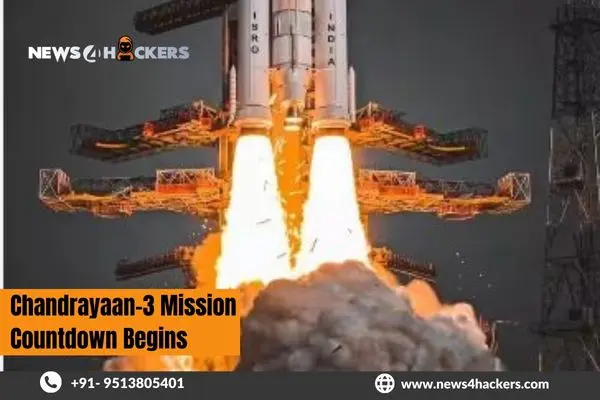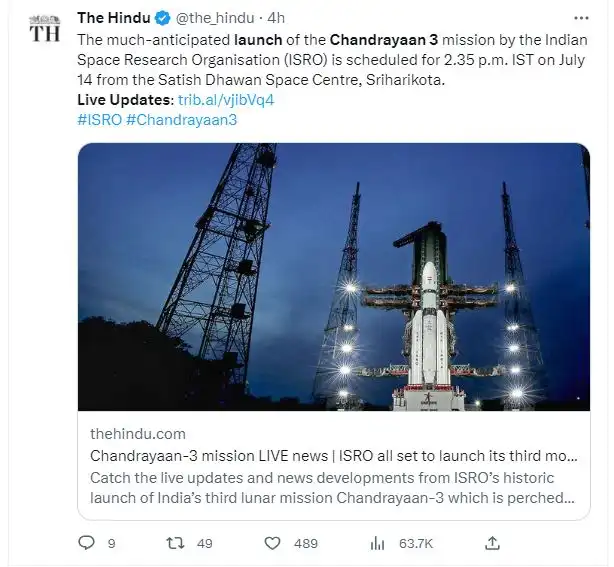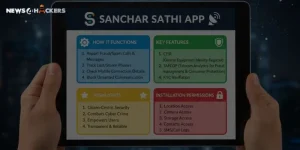Chandrayaan-3 Mission Countdown Begins; India is Ready to Step on the No-Fly Zone of Lunar Surface.

The Chandrayaan-3 mission’s secure and delicate lunar surface touchdown demonstration, moon rover wandering, and in-situ scientific experimentation are all planned for the moon.
Sriharikota: India will be the 4th country with a spacecraft on the moon when the Chandrayaan-3 mission countdown begins.
India will become the 4th nation to successfully land a spacecraft on the moon with Chandrayaan-3, the third and the latest lunar exploration mission, showcasing the nation’s prowess for a secure and gentle landing on the lunar surface.
Prior to the mission’s takeoff from the Satish Dhawan Space Centre in Sriharikota on Friday, the countdown started yesterday, and only a few hours were left before the launch.
The mission preparation review has been finished. The launch has received board approval. Tomorrow marks the start of the countdown, the ISRO tweeted.
It will be launched using a heavy lift launch vehicle called the GSLV Mark 3 (LVM 3).
After the Chandrayaan-2 mission encountered difficulties during its smooth landing in 2019, the Indian Space Research Organization (ISRO) will attempt this as a follow-up.
The ISRO has finished its ‘Launch Rehearsal,’ which simulated the complete launch preparations and procedure.
Chandrayaan-3, if everything goes according to plan, is expected to be the very first spacecraft to touch down on the Moon’s South Pole, showcasing India’s technical ability and audacious spacefaring objectives.
The Chandrayaan-3 mission’s secure and delicate lunar surface touchdown demonstration, moon rover wandering, and in-situ scientific experimentation are all planned for the moon.
The eagerly anticipated Chandrayaan-3 was launched on schedule, and ISRO allowed the public to watch from the Sriharikota viewing gallery.
When the Chandrayaan-2 lander was just a bit farther away from the moon’s surface, ISRO lost touch with it.
The spacecraft that will soon be launched is predicted to travel to the moon in about a month, and its landing is anticipated on August 23. It will run for one lunar day after landing, which is equivalent to 14 days on Earth. Hence, you can understand that 14 days on Earth are equivalent to one day on the moon.
The successful completion of mission Chandrayan-3 will bolster the morale of initiatives like Gaganyan, according to K Sivan, a former director of ISRO, who spoke to the press.
“We identified the issues that caused Chandrayan-2 to malfunction when it attempted to land on the outermost layer of the moon. We then replicated the failure scenarios and made sure that this time would be different. The difficulty and landing environment are exactly the same as for Chandrayan-2. On the basis of the lesson of Chandrayan-2, which gives us greater trust, we hope that this time we have accomplished enough. There are always unknowns in space; let’s hope that all of them are resolved, and we come out on top,” he said.
“Technology is touching down on a celestial body. We will obtain landing technology if we land effectively, which will benefit future generations as well. Scientists will learn more about the geology of the moon and the origin of the planet thanks to a number of scheduled scientific investigations, he added.
Chandrayaan-3 is a crucial mission, according to Mylswamy Annadurai, the mission director of Chandrayaan-1.
“We have demonstrated orbital capability, but we were unable to do a landing that was smooth. By succeeding this time, we can demonstrate that Chandrayan-1 was not an exceptional achievement. Internationally, everyone is turning their attention to the moon; Chandrayaan-1 provided the actual impetus for this. Therefore, we must accomplish our task,” he told the press.
“From Chandrayaan 1 and 2, challenging insights came to light. We are expected to have a backup plan at every turn. Chandrayaan- 2 experienced some setbacks. We are getting back on track this time. We know exactly what we want to accomplish, and doing it will guarantee that we can gently touch down the moon’s surface. We hope this is a success; the target of landing is also larger, and all components have undergone extensive testing,” he continued.
The COVID-19 pandemic delayed the development phase of Chandrayaan-3, which was supposed to launch sometime in 2021 after it started in January 2020.
The Chandrayaan-1 mission, which was launched in 2008, made its most important finding when it found water (H2O) and hydroxyl (OH) on the lunar surface. Data also showed that they were more plentiful near the poles.
“The primary science purpose of the spacecraft’s mission was to put together a 3-D atlas of both the close and far ends of the Moon and to carry out chemical and mineralogical imaging of the whole lunar surface with high spatial resolution,” according to a statement from the Vikram Sarabhai Space Centre, an ISRO organization.
A successful lunar mission by India will contribute to improving life on Earth and get us ready to explore the rest of the solar system and beyond. The moon is a repository for the history of the planet.
According to S Somanath, the existing director of ISRO, if all goes smoothly, the spacecraft is scheduled to land on the moon on August 23.
The landing may happen next month, he said, even though the date was chosen based on the moon’s sunrise.
About The Author:
Yogesh Naager is a content marketer that specializes in the cybersecurity and B2B space. Besides writing for the News4Hackers blog, he’s also written for brands including CollegeDunia, Utsav Fashion, and NASSCOM. Naager entered the field of content in an unusual way. He began his career as an insurance sales executive, where he developed an interest in simplifying difficult concepts. He also combines this interest with a love of narrative, which makes him a good writer in the cybersecurity field. In the bottom line, he frequently writes for Craw Security.
Kindly read other news articles:
Cyber Fraud involved ₹ 12.8 Crore from Noida Authority’s FD A/cs in BOI
Following the LockBit intrusion on a third-party supplier, TSMC confirms a data breach.










